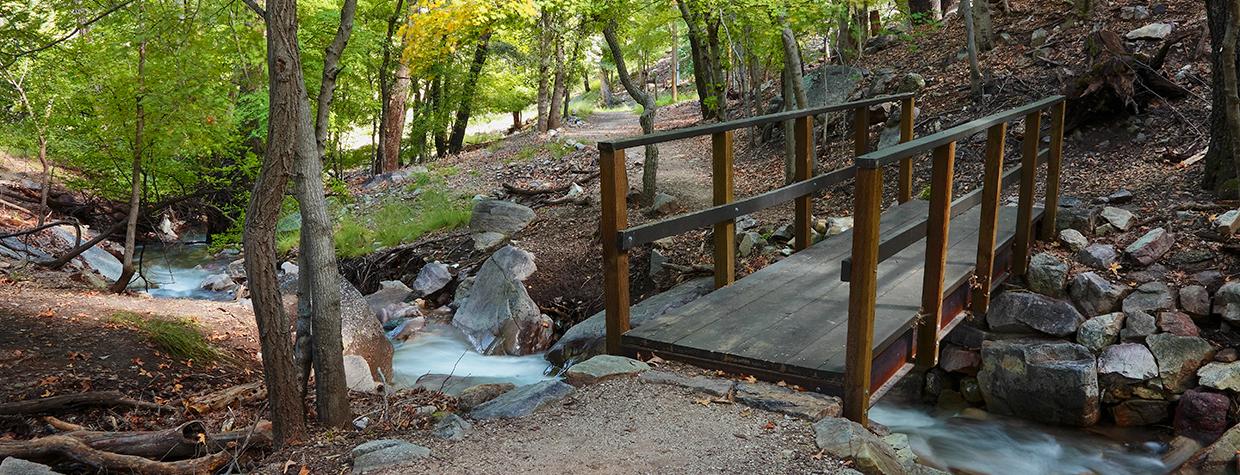“Ramsey chokes on quiet,” Charles Bowden wrote in the November 1982 issue of Arizona Highways. “A blue-throated lizard scoots up a tree. The snap of a twig gives away a white-tailed deer moving up the slope. There is bear scat heaped by the trail, bristling with javelina hair. The bruin mauling the canyon’s apples evidently found a lion kill. Above us, a hawk wheels on a thermal.”
There are better-known canyons in Arizona — Canyon de Chelly, Oak Creek Canyon, the Grand Canyon — but Ramsey Canyon belongs on any list of the state’s most spectacular chasms. Unlike the others, Ramsey is not defined by broad panoramas. Rather, it’s the intimacy of this wooded wonderland that makes it so special. No doubt, that’s what enticed William Berner, a German immigrant who found the canyon in 1882 and never left.
He wasn’t the first, though. Before him, Apaches had made camp under the towering sycamores, and prospectors had poked around looking for gold. Berner saw things differently. He saw an oasis and kept busy planting trees and putting up cabins for people fleeing the summer heat.
Today, Ramsey Canyon, which is named for Frank Ramsey, a cowboy from Kansas, is a Nature Conservancy property. When it was gifted to the nonprofit by Nelson C. Bledsoe, who’d inherited the land from Berner, it was stipulated that the property be used for scientific, educational and aesthetic purposes “without any disturbance whatever of habitat, plant or animal populations.” The Conservancy has kept its end of the bargain. You’ll see that firsthand on the Hamburg Trail.
But before you get started, you’ll have to obtain a permit from TNC’s visitors center — the first mile of the hike crosses its preserve. The fee is minimal. And so is the parking. There are only 27 spaces, which are gobbled up first-come, first-served. The scurry is worth the effort, though. This is Mother Nature at her finest.
A spring-fed stream and high canyon walls provide Ramsey Canyon with a moist, cool environment that’s uncommon in the Sonoran Desert. It’s a sanctuary that attracts birds from all over North America. If you know what you’re looking for, depending on the time of year, there’s a good chance of seeing dark-eyed juncos, ruby-crowned kinglets and 15 species of hummingbirds. You might see Coues white-tailed deer, too, which wander in and out of the creek without any apparent fear.
The trail begins at the back door (literally) of the visitors center, and the first thing you’ll see is Ramsey Creek, a key tributary of the San Pedro River. About 10 minutes later, you’ll come to the James Cabin. It was built in 1902, and as you stand there looking around, you’ll agree that few cabins in the history of westward expansion could have had a better view. The scenic backdrop is impressive, and so is the Arizona sycamore that’s growing nearby. It might not be the oldest tree in the canyon, but it dates back to 1760, which makes it older than the United States. And older than Cochise, who might have taken shelter under its canopy while drinking water from the creek.
From the big tree, the trail moves uphill to a set of steep switchbacks that climb about 500 feet to a beautiful point that looks back at lower Ramsey Canyon and the San Pedro River Valley. Just beyond the overlook, which is about a mile from the visitors center, you’ll cross into the Coronado National Forest and the Miller Peak Wilderness.
Continuing south, the trail drops back down to the creek and follows the waterway through a riparian zone as lush and beautiful as any you’ll find in the Southwest. Imagine having the West Fork of Oak Creek all to yourself.
Along this stretch, small waterfalls tumble past gnarly sycamores and lacy-limbed firs, and the trail crosses the creek several times as it climbs toward the upper elevations of the Huachuca Mountains. About a half-hour in, you’ll come to an intersection with the Brown Canyon Trail, which veers right. That’s followed, about 20 minutes later, by an intersection with the Comfort Springs Trail, which veers left. Two hundred yards farther, you’ll come to an intersection with the Pat Scott Canyon Trail. This is where Pat Scott Canyon and Wisconsin Canyon meet.
It’s also the turnaround point for this hike. However, if you have the time and the stamina, you can continue a mile and a half through Wisconsin Canyon to Bear Saddle and the Crest Trail, which runs along the spine of the mountain range. Either way, take a look around. Where the canyons meet, you’ll see the remains of some leveled homesites that were part of Henry Hamburg’s mining camp. There’s not much left, but there are remnants. Better yet, there’s solitude. And intimacy. That’s what defines this canyon.
trail guide
Length: 5 miles round-trip (from visitors center)
Difficulty: Moderate
Elevation: 5,579 to 6,907 feet
Trailhead GPS: N 31˚26.860', W 110˚18.443'
Directions: From Sierra Vista, go south on State Route 92 for 6 miles to Ramsey Canyon Road. Turn right onto Ramsey Canyon Road and continue 3.5 miles to The Nature Conservancy’s Ramsey Canyon Preserve parking area and trailhead.
Special Consideration: An entrance fee of $8 is required; children under 13 are free. The preserve is open from 8 a.m. to 5 p.m. in the summer and is closed Tuesdays and Wednesdays.
Vehicle Requirements: None
Dogs Allowed: No
Horses Allowed: No
USGS Map: Miller Peak
Information: The Nature Conservancy, 520-378-2785 or nature.org/arizona

